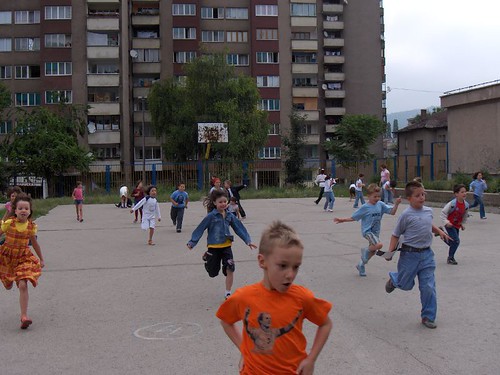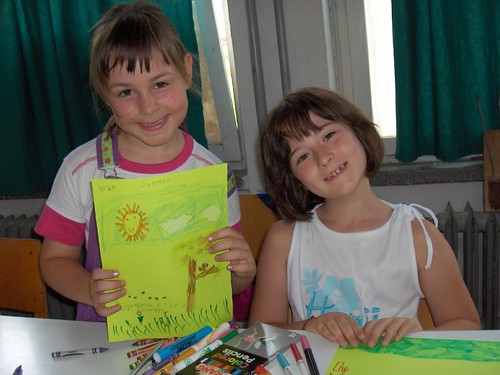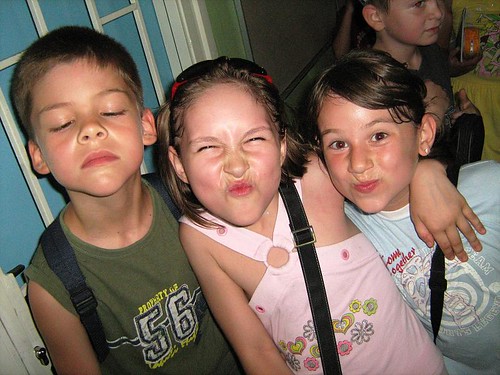Swarthmore College: Jess Engebretson '09, Andrew Loh '10, Trude Raizen '08, Lisa Riddle '09, Deivid Rojas '11
Davis 100 Projects for Peace: Swarthmore Bosnia Project

Introduction
The third largest city in Bosnia, Zenica was largely destroyed during the 1992 Bosnian War. The city suffers from nearly 40% unemployment and its economy is stagnant. In the course of the war, many Muslims sought refuge in Zenica from ethnic cleansing in other parts of the country, while large numbers of Serbs and Croats fled the city for Serb and Croat majority areas of the country. Consequently, the ethnic diversity that existed in pre-war Zenica has been mostly lost: in 1991 the population was 55% Bosniak (Bosnian Muslim), 15% Croat, 15% Serb, and today it is 90% Bosniak.
The Swarthmore Bosnia Project is a new initiative that will send students each summer to help strengthen the communication and conflict resolution skills among children in Zenica. Coordinated jointly with SEZAM, Zenica's first non-governmental organization, the Bosnia Project will address the volatile situation in Zenica by providing educational programs for children that focus on cooperation and inter-ethnic understanding in a society that is still polarized by history, politics, and ethnicity.
SEZAM provides the only summer program in a city where children would otherwise be out on the streets in a city known for crime and drug issues. The program has proven to be very popular among both students and parents. The kids embrace the opportunity to spend time with their friends and Americans, while parents value the structured environment and opportunity for their children to learn English in a city where very few adults speak English. Additionally, Swarthmore students will work with Bosnian college students in the classroom, fostering cultural understanding and providing jobs for these students in the economically depressed city.
SEZAM's support for the Bosnia project has been consistent and enthusiastic. The genesis of the Swarthmore Bosnia project dates back to the summer of 2006, when Jess Engebretson '09 worked with SEZAM through a project affiliated with the College of William and Mary (W&M) -- and SEZAM's leader Venira Alihodzic said that she would love to see SEZAM expand their collaboration to other American colleges. This year will see a pioneering batch of four Swarthmore students (Andrew Loh '10, Trude Raizen '08, Lisa Riddle '09, Deivid Rojas '11) going to Zenica to expand the Bosnia Project. We hope that this pilot project will fulfill the desire of the host community in increasing the number of children the Bosnia Project can support by about 150 students this summer. Our goal for next year is to expand the program to six or more Swarthmore students.

Objectives
The Bosnia Project is primarily designed to improve the children's ability to communicate—both in English and Bosnian—in a society that is still segregated and polarized. Each summer, the team spends four weeks teaching English and conflict resolution to ethnically-integrated classes. By doing so, the program hopes to help heal the wounds of a conflict that has split apart nations, villages, and even families.
- Given the lack of opportunities for children in Zenica, the Bosnia Project strives first of all to create an environment that is safe and enjoyable for the children, a program that will allow them time with their friends engaged in games and art. There are no other summer programs in Zenica at all, and very few elsewhere in Bosnia.
- The project also seeks to improve the students' knowledge of English. By approaching the study of English through games, crafts, and themed activities, the Bosnia Project aims to make academic study enjoyable and approachable for the students. Since few parents in Zenica speak English, the Bosnia Project presents a unique and exciting chance to learn English from native speakers.
- Finally, the Bosnia Project seeks to teach non-violent methods of communication. By working through cooperative rather than competitive games, modeling respectful discussion, and helping defuse fights and disagreements among the students, the team members emphasize the importance of peaceful discussion and disagreement. The Bosnia Project thus presents an unusual alternative to the typical experience of the children; one that is particularly necessary in a city as polarized and scarred as Zenica.

The Project
- The classroom component is the main focus of the project. Classes run from 8:30 AM to 2:00 PM for four weeks, but extensive planning will be conducted after hours both to prepare and evaluate classroom activities. We will generate the entire curriculum and provide all classroom supplies. The team will also have weekly meetings to keep the syllabus consistent and thus allow integration and large-group activities whenever possible. Students teach in pairs and also team up with a college-age Bosnian facilitator, who helps translate instruction and provides general assistance. Each pair will teach three classes of approximately fifteen to twenty-five students in grades first through seventh, divided by age.
- The inclusion of games is also a major part of classroom time, especially games that stress cooperation, teamwork, use of English, and relation to daily themes. The program allows use of the schoolyard for this purpose, and past groups have also encouraged Bosnian students to suggest or teach Bosnian games, songs, or other activities and thus foster an environment of cultural exchange.
- Some evenings will be spent holding two-hour conversation classes with adults in Zenica who wish to improve their English. Many of the participants in these classes are university students, politicians, and business people – those whose careers would be greatly advanced by higher proficiency in English.
- Participants will live with host families to facilitate cultural immersion. Most of the host families are highly connected to or invested in the Bosnia Project and the goals of SEZAM. Past participants have formed close, meaningful relationships with their host families.
- We will work closely with SEZAM on the Bosnia Project. Initially, SEZAM conducts introductory meetings to discuss the impact of the war on Zenica, introduce translators, suggest teaching assignments, and help orientate the group to their new surroundings. SEZAM also offers the use of their offices for classroom planning sessions, and are willing to travel to the elementary schools for weekly meetings to discuss questions, concerns, and successes related to individual students or the program as a whole.
- After four weeks of teaching, we will work with SEZAM to conduct a survey and evaluation of the summer's activities in order to strengthen the program for the following year.
The Bosnia Project has been a huge success over the years. Highly popular among both children and parents, the major factor constraining its growth has been the limited number of English teachers, something we hope to address with this first-ever Swarthmore Bosnia Project. At least 80% of students in the program are returnees – indicative of a successful program that draws people back while expanding every year.
We believe that the popular response among community members and SEZAM's desire to expand the program speak to the Bosnia Project's benefits and successes. We hope that our team will be able to extend the benefits of the Bosnia Project to more children: to provide a fun, safe and cooperative environment for children in otherwise volatile surroundings, to continue enhancing the English skills of Zenica's students and provide them with skills for further development, education, and empowerment, and to build non-violent methods of communication and inter-cultural understanding. We hope that the Bosnia Project will be a catalyst for long-term peace and understanding in Zenica and beyond.
Reference: Ethnic composition of the population of Bosnia-Herzegovina, by municipalities and settlements, 1991.
Photos: Jess Engebretson

1 comment:
nice first post, Andrew!
Post a Comment